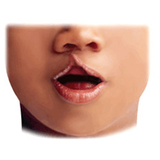Cleft Lip and Cleft Palate Repair: Sophia’s Story
Cleft Lip and Cleft Palate Repair: Sophia’s Story
At a routine 20-week ultrasound, Karlie and Eric Shrive, already parents to a healthy little boy, Connor, were excited to learn the gender of their second child. What they did not expect was for the ultrasound to reveal that their daughter would be born with a cleft lip.

This unanticipated finding led them to the Division of Plastic, Reconstructive and Oral Surgery at Children's Hospital of Philadelphia (CHOP), where their team included Oksana Jackson, MD, and Nancy Folsom, RN.
“From day one we researched hospitals, and when we met the people at CHOP, we decided our daughter would get the best care there,” says Karlie. The family also had access to the resources at CHOP’s Center for Fetal Diagnosis and Treatment, where Karlie had a CAT scan, an ultrasound and other tests. While the couple was comforted in finding out that their baby girl was otherwise healthy, they did find out that the cleft also was suspected to be in the roof of mouth, known as the palate.

More about cleft lip
Cleft lip and palate are birth defects in which the mouth and lip do not close properly during prenatal development.
Time to plan
Cleft lip and cleft palate is a congenital birth difference of the upper part of the mouth and lip. This happens early during pregnancy when the lip and roof of the mouth do not join together properly, creating a visible opening. The cause is not fully understood.
After Sophia was born and assessed, Karlie and Eric were told that their daughter would need more than one medical intervention to repair her cleft. The first step would be nonsurgical and would require a specially trained orthodontist to help reshape the lip and nose before surgery. This process is called nasoalveolar molding, or NAM, and is done by using a series of molds combined with lip taping to bring the lip edges closer together and shape the nasal cartilages. This began shortly after birth and continued until surgical repair of the cleft lip at around 4 to 6 months of age. A second surgery would be needed at around the time of her first birthday to repair the cleft in the palate.
Karlie and Eric each had their own concerns about the procedures. “You wonder how she’ll look coming out of the surgery, because you fall in love with her one way,” Karlie says. “Will we have to get used to our daughter looking different?”
Adds Eric: “I was concerned about what she’d look like for the rest of her life. I wanted to make sure that her face would appear symmetrical.”
Keeping the family informed
The couple did not worry for long. Dr. Jackson inspired confidence, and Nurse Folsom provided frequent updates during each of Sophia’s two-hour-long procedures.
“Nancy was able to give us updates throughout and keep us informed as the minutes passed. It was helpful having her provide inside knowledge of what was happening with Sophia,” says Karlie.
After each surgery, Sophia recovered quickly. “We were in the hospital for one night for the surgeries,” says Karlie. “For the cleft lip repair, it took one week for her to recover, and we had to get used to not seeing a hole in her lip. She recovered from the cleft palate repair in two days, then she was back eating regular baby food.”
The CHOP team provided critical support for the couple as Sophia recovered at home.
“We knew we could pick up the phone, and Nancy would answer any time of the day, and we could personally talk to Dr. Jackson, even right after the surgery,” says Karlie. “She helped us with details like caring for Sophia’s nose stent and teaching her how to eat after the repair.”
A care team that’s like family
Sophia’s medical team went beyond the Shrives’ expectations when it came to their daughter’s care: They took a very personal approach, and ensured that both parents were always supported and informed.
“The hospitals [in our hometown] were not prepared to take care of Sophia, and from the beginning, Nancy always responded quickly to help with feeding, for example,” says Karlie. “The day of the palate repair, Nancy was scheduled to take the day off in order to move, and she came in to be with us. She became part of our family.”
The Shrives worked with Dr. Jackson and the team at CHOP to develop a plan for Sophia’s future care. Once a year, Sophia will see Dr. Jackson and the whole cleft team, which includes medical assistants and the nurse navigator — who make sure the day runs smoothly and is fun for the children and their families — pediatric nurse practitioners, the plastic surgeon, a speech and language therapist, an audiologist, a dentist or orthodontist, and a behavioral health specialist.
Sophia will need another surgery when she is about 6 or 7 years old to repair the cleft in her gums, an important step in making sure her teeth remain healthy.
Now a happy 2-year-old, Sophia is currently in speech therapy. “Developmentally, she’s doing fine, and she comprehends so many things,” says Karlie.
“’Fearless’ is one word we always use to describe Sophia,” says Eric. “She’s willing to do anything and has the spunk to try to do it.“
“[The team at CHOP] did so much for us,” says Karlie. “Our daughter is thriving now.”